When you are suffering from sciatica due to a disc problem, it is absolutely reasonable to ask about bulging disc recovery time, and whether you can heal a bulging disc without surgery or not. The aim of this article is to answer all your questions about how long a bulging disc takes to heal, whether surgery is really needed and what to do to speed up bulging disc recovery time.
Aims of this post:
- To answer the question: “How long does a bulging disc take to heal?”
- To discuss who might or might not need surgery for their sciatica
- To give you a rough idea as to the typical bulging disc recovery time
- To teach you the TRUTH about discs in the spine
- To teach you about the different types of surgery commonly offered for disc problems
Before we dive in, please be aware that we are part of the Amazon Affiliate programme. This page may contain Amazon affiliate links, so if you choose to purchase a product for your sciatica that we recommend through a link on this page, we will receive a small commission at no extra cost to you. This helps us keep Overcome Sciatica alive! Thank you for your support. Please be assured that we only ever recommend products that we truly believe can help.
Bulging Disc Recovery Time – Is Surgery Always Needed?
Bulging discs are a very common cause of sciatica. It is estimated that a problem with the intervertebral discs of the spine is to blame for over 70% of cases of sciatica.
What are intervertebral discs?
Let’s first recap on what intervertebral discs are and what they do within the spine. Discs are the shock absorbers that sit between the bones in the spine (vertebrae). They are ring-shaped and are made up of two distinct parts.
The first part is the outer ring, called the annulus, which is made up of tough cartilage and proteins packed into strong layers. Within this sits the second part of the disc, called the nucleus, which is a jelly-like liquid that provides nutrients to the vertebrae and lubrication during spinal movement. This nucleus moves around within the annulus as we move, and plays a key role in allowing us to bend and lean as we go about our day. At each level of the spine, exiting the spine near where the discs sit, are the nerve roots. These nerve roots will become the nerves that supply sensation and movement to the limbs and the rest of our bodies.
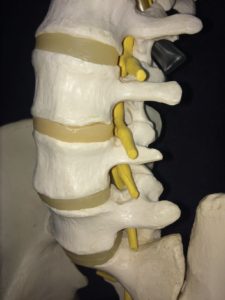
You can read more about how a disc works and the symptoms a disc problem can cause by reading this post HERE.
What is a bulging disc?
A bulging disc can also be known as a “slipped disc” or “protruding disc”. The most significant version of this injury is known as a “herniated disc”, where the inner disc material escapes from the outer layer (annulus) of the disc. If you sustain an injury to the annulus of your disc, the nucleus can push on the weakened area and protrude outwards. This is called a disc bulge.
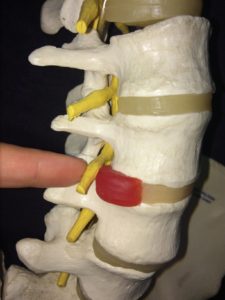
It is possible to have a disc bulge and know nothing about it. A lot of the time, a disc bulge can be completely pain free. However, if this disc bulge touches on one of the nerve roots that we spoke about earlier, you can develop the symptoms of sciatica. You can read all about the symptoms of sciatica in my Ultimate Guide HERE.
How does a bulging disc cause leg symptoms?
Usually, when you get a bulging disc, the symptoms of your sciatica will reflect the level of nerve root within the spine that the disc bulge is irritating. Note that this does not necessarily mean that you will get your symptoms at the level of the disc bulge… Let me explain.
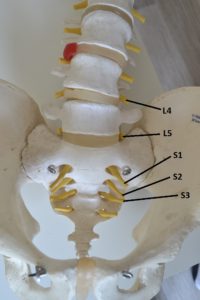
When you sustain a disc bulge at level L4/L5 (second from bottom disc) in the spine, you may get an irritation of the L5 nerve root, which exits at the level of your disc problem.
However, due to the effects of gravity, if any material has leaked out from your disc at L4/L5 it will travel downwards within the spine. This means that you may get symptoms reflecting an irritation of the S1 nerve root (just below the base of the spine) due to the inner disc material having traveled south within your back. This may affect your bulging disc recovery time.
It is also possible that the inflammatory chemicals that appear in our spine when we suffer a disc injury irritate the levels below the injury too. The presence of these inflammatory chemicals is likely to increase your bulging disc recovery time. This video provides a great explanation for how a disc bulge can cause sciatica:
Why me??
Usually, it isn’t that you’ve done anything wrong!
Repetitive stress
Often, there is a pre-existing weakness in the annulus of one of your discs, caused by repetitive micro-trauma over time through repeated actions and just living your day-to-day life. This can then lead to a disc bulge over a period of time.
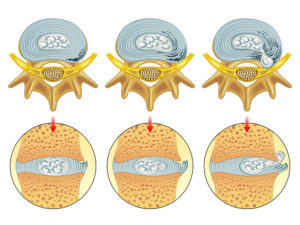
To learn how to avoid repetitive stress in the workplace and allow your disc bulge to heal while you work, click HERE.
Accident
Sometimes, an explicit event can cause your disc bulge when the spine is moved in such a way as to cause a sudden increase in the pressure within one of your discs, causing a tear to occur in the annulus of a disc. This is often the case in car accidents, or during poor lifting techniques under too much load (e.g. trying to pick up a huge weight from the floor while twisting).
Genetics
There also may be genetic factors to explain why you are suffering from a disc bulge and the associated symptoms of sciatica. This is because some people are born with less fibres in the annulus of their disc. This predisposes their discs to weakness, and makes a disc injury or bulge through repetitive strain more likely. It’s important to say here that we shouldn’t stress about the genetic factors relating to our sciatica! We can’t change our genetics, and it is thought that overall bulging disc recovery time isn’t overly affected by our genetics. Factors such as diet (see here), lifestyle (see here) and stress (see here) are all much bigger factors in our recovery.
Are You Looking for RAPID Relief from Sciatica?
My good friend, colleague and fellow international sciatica expert, Dean Volk, has a brand new sciatica relief video course available – and I’m delighted to be an official sponsor!
Check out Dean Volk’s “Kicking Sciatica OUT of the Butt!” Online Pain Relief Course Here!
I can proudly recommend Dean and his course for sciatica sufferers – because I’ve seen his incredible results first-hand. You can check out his course (and get lifetime access to the videos and bonus content) by clicking HERE.
How long will I be off work with a bulging disc?
Many of the people asking the question “How long does a bulging disc take to heal?” are worried about how long it might keep them off work.
The answer is: It depends. It depends on how much pain you are in. It depends on whether you have weakness in your legs. It depends on how much lifting is involved in your job. It depends how much sitting you will need to do each day and whether sitting aggravates your bulging disc.
To give you an idea of how long it might take, most people do not need more than a few weeks off work at the most. It is typically better to continue working as much as you can as taking too much rest often makes the problem worse.
See if your employer can modify your work tasks so you can still complete them without aggravating the bulging disc.
Can a bulging disc heal without surgery?
In short, the answer is absolutely YES. We think that the actual statistic for how many disc bulges recovery naturally, if the body is optimised for a short bulging disc recovery time, is 90% of people recovering within 12 weeks.
Unfortunately, this is not always the case, and some people remain in pain past the 12 week mark.
If this sounds like you, make sure you are doing everything you can to optimise your body for a recovery from sciatica.
When a person recovers from a bulging disc, the body is able to clear any “debris” from the injured area through clever cells in the blood stream. The inner disc material is able to return to the nucleus within the disc over time. The annulus then “knits” back together, allowing the disc to return to a healthy state. This is all dependent on the person suffering from the injury managing to avoid any aggravating activities in their day to day life.
It is worth noting that, during the healing process, the disc is quite vulnerable to a re-injury for up to 6 weeks. However, this sense of vulnerability can remain for quite some time after. A large part of the reason for this is due to subconscious fear of a re-injury.
The fear of re-injury can actually directly increase your bulging disc recovery time. I talk more about what this is and how to beat it HERE.
When is surgery required?
Some people with a bulging disc will require surgery if their disc is not healing for a certain reason. The surgeries that are chosen will usually aim to “decompress” the nerve root that is being compressed by the disc material. Most of the surgeries involve taking away some of the disc or a piece of bone within the spine to allow the affected nerve root to move, glide and send messages more freely. The names of these surgeries include “microdiscectomy”, “lumbar decompression” and “laminectomy”. These surgeries are reserved for people who have seen next to no improvement during a reasonable bulging disc recovery time period. After surgery, recovery time periods can range from 6 to 12 weeks, to longer in more complex cases. However, during these time periods, the amount of activity you are allowed to perform is far more limited than during the average bulging disc recovery time period without surgery.
How long does a bulging disc take to heal without surgery?
There is no simple answer to this question. Everyone is different and it is difficult to tell who is going to improve very quickly, and who will have a long drawn out bulging disc recovery time. However, as a rough guideline I would expect a recovery to follow this pattern in an absolutely “typical” individual:
| When? | Stage of recovery |
| Day 1 | Disc injury occurs – OUCH! |
| Week 1 | In lots of pain, struggling to get to work or get comfortable at home. Probably feels like you want to cut your leg off. |
| Week 2 | Starting to take the right pain killers, this helps a bit. Work is a killer, leg still extremely painful. |
| Week 4 | Starting to improve slightly after making appropriate lifestyle changes, optimising diet and using the specific exercises to my individual problem. |
| Week 6 | Feeling significantly better. Feeling like you can get through a day at work without too much pain in the evening. Still very wary of your back. |
| Week 9 | Leg is much better but back still stiff. Trying to get that last bit of movement back now. Terrified of the thought of swinging a golf club again. |
| Week 12 | Through practicing methods in order to regain normal function, you’re seeing an improvement in confidence. You feel ready to go back to the things you love but know you need to still be cautious for a while. |
As you can see, recovering from a bulging disc is not a quick thing! It is likely to dominate your life for a few weeks – but that’s OK. Get it right here and you are less likely to suffer with a recurrence later on.
Remember, everyone is different in terms of bulging disc recovery time. I have seen patients who feel no better after 12 weeks of treatment, and I have seen patients who report being 90% better after one week. This statement still stands when you compare the initial severity of each of these cases.
Disc Surgery
Surgery is occasionally required when your leg pain fails to settle after 6-12 weeks of treatment. You may also require surgery if you are experiencing any of the “red flag” symptoms that can indicate a more serious nerve compression. These symptoms include (but are not limited to):
- Bladder and bowel problems (like incontinence or not being able to “go”)
- Numbness in the saddle region
- Severe loss of strength in the legs
In all cases you should get a professional opinion from a doctor or physiotherapist specific to your personal circumstances.

The surgeries that are offered to people whose bulging disc recovery time exceeds what is expected are as follows:
- Microdiscectomy: Where a small part of the offending disc is removed in order to decompress the affected nerve.
- Laminectomy: Where a part of the vertebral bone in the affected level called the “lamina” is removed, in order to create more space for the disc in hope that the bulge will not compress so heavily on the nerve root.
- Spinal fusion: Where the disc is removed and the vertebrae above and below the offending disc are fused together through use of rods and screws.
Is there anything I can do to speed up my bulging disc recovery time?
In most people, it is indeed possible to accelerate your bulging disc recovery time through lifestyle changes. I have attempted to cover these lifestyle changes through the information on this website.
In the following video, I’ll give you 8 strategies for SPEEDING UP bulging disc recovery time:
Summary
I hope the information in this article has helped to clear up a few things about whether or not a disc bulge can recover naturally through conservative measures or whether surgery is needed. If you’re worried about your symptoms or have developed a new onset of sciatica, it is always advisable to be assessed properly by a qualified medical professional.
If you have found the information within this page useful or informative, by sharing this article with a friend or on social media you can help someone else make a better decision about their recovery from sciatica, too.
Through better information about how we recover from sciatica, I feel as though more people will be able to avoid unnecessary surgery, which would be a fantastic outcome!
Remember to comment below if you have any thoughts or questions about any of the above! Thank you so much for reading, I really appreciate your time.
Are You Looking for RAPID Relief from Sciatica?
My good friend, colleague and fellow international sciatica expert, Dean Volk, has a brand new sciatica relief video course available – and I’m delighted to be an official sponsor!
Check out Dean Volk’s “Kicking Sciatica OUT of the Butt!” Online Pain Relief Course Here!
I can proudly recommend Dean and his course for sciatica sufferers – because I’ve seen his incredible results first-hand. You can check out his course (and get lifetime access to the videos and bonus content) by clicking HERE.
The information on Overcome Sciatica should never be used as a substitute for medical advice from a doctor. Never put into action any tips or techniques from Overcome Sciatica without checking with your doctor first. Please see full terms of use here.

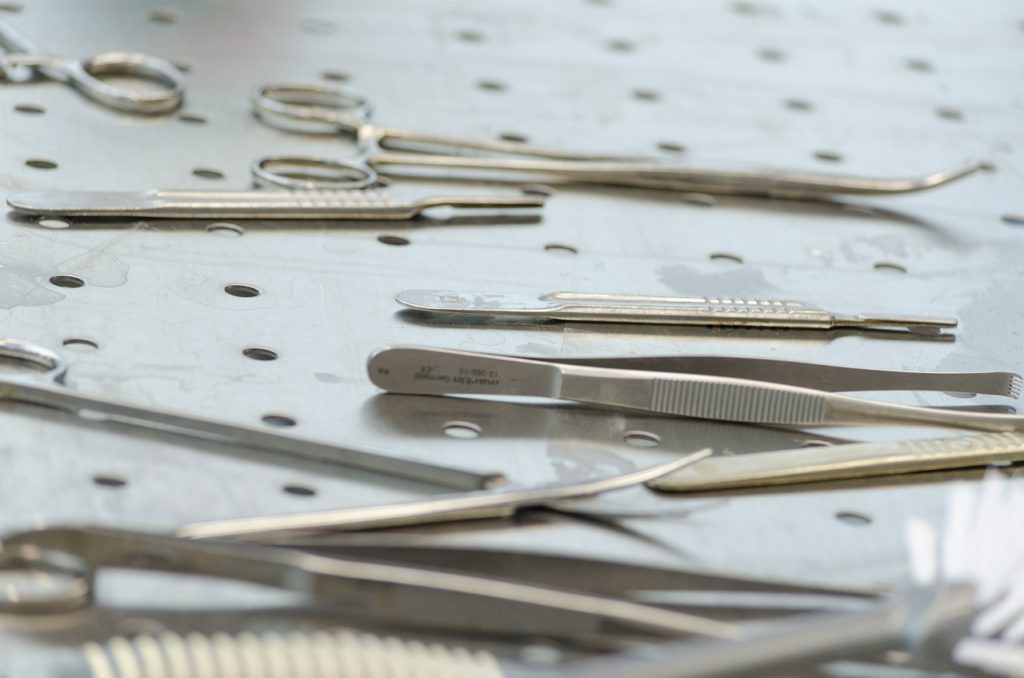
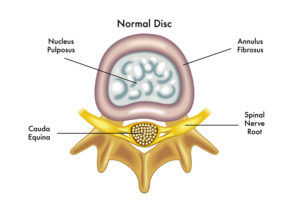

Hi. I just discovered your website and it’s a wealth of helpful information so thank you first of all. I have a question regarding “sleeping pillows” for sciatica. I’m seeing many different versions on Amazon and wondering if these really work to alleviate leg pain while sleeping. They’re the ones that you place between your legs while sleeping. What’s your opinions on them? I did a search on your site and couldn’t find any information specifically on those. Thanks!
Hi Christopher, thanks for your kind words! The short answer is it depends. For people who’s sciatica is caused by piriformis syndrome or a problem/imbalance in the hips, the sleeping pillows can be extremely helpful. However, for others, they make no difference. A good way to tell is by seeing how you feel when sleeping on your side: is it comfortable? Now, try placing a normal pillow between your legs – does that improve pain or comfort? If so, you may benefit from one of the sleeping pillows. If not, you’re probably better off looking elsewhere. Hope that helps!
Hi. I was diagnosed via an MRI scan with a bulging disc. However, when it came to surgery, it was found to be a pea sized piece of disc that had almost detached itself and had got wedged between the lower disc and sciatic nerve. The pain was indescribable!!! But when the op was performed, it removed the piece and smoothed off the remainder. It has taken 9 weeks to get pain relief, but it came like a miracle!!! In a 3 hour period, I went from having pain across the whole lower back, not being able to stand upright or walk, to being 95% back to normal. Sometimes surgery is the only way forward, you can stretch, bend, be manipulated etc, but if it comes down to it, surgery may be the only option. Not without risk but in my case perfection!!!!!!!!!!!!!!!!!!!!!!!!!! Thank you Mr H, my consultant, and Sarah, Physiotherapy. Great job! I got my life back! Chris
It is a very helpful article the information is very clear and informative. I have been wondering when and how will I get better. I had an accident in May 2020 but my pains get better sometimes and there are also some tough days during the week.
Thanks a lot
I found this article to be very helpful, even though my problem is at my C8 level disk.
At times my left arm felt as if it is was ripped from my body. I can only compare to sciatica problems.
I am about 7 weeks into recovery right now. The healing scale given above fits me perfectly. I am feeling better, but fear about reinjuring myself. I am normally very active, and have a hard time slowing down.
Looking forward to the next few weeks and hopefully full recovery.
Thank you for this type of article to give up comfort and hope.
Amazing article.
I had an accident a week ago and an MRI scan revealed a bulging L3/L4 disc, a herniated L4/L5disc and a compressed L5/S1 disc. The pain down to the leg is immense, the amount of painkillers and anti-inflammation pills I take is beyond thinking but after reading this article, I can clearly see light at the end of the tunnel. I understand more and I feel more educated as well.
Thank you very much!
Thank you very much for the rich educational information you shared, I now have a clear view of what is happening to me.
I am seeing a doctor today whatever they recommend I will use your advices
Thank u for your Helpful information…